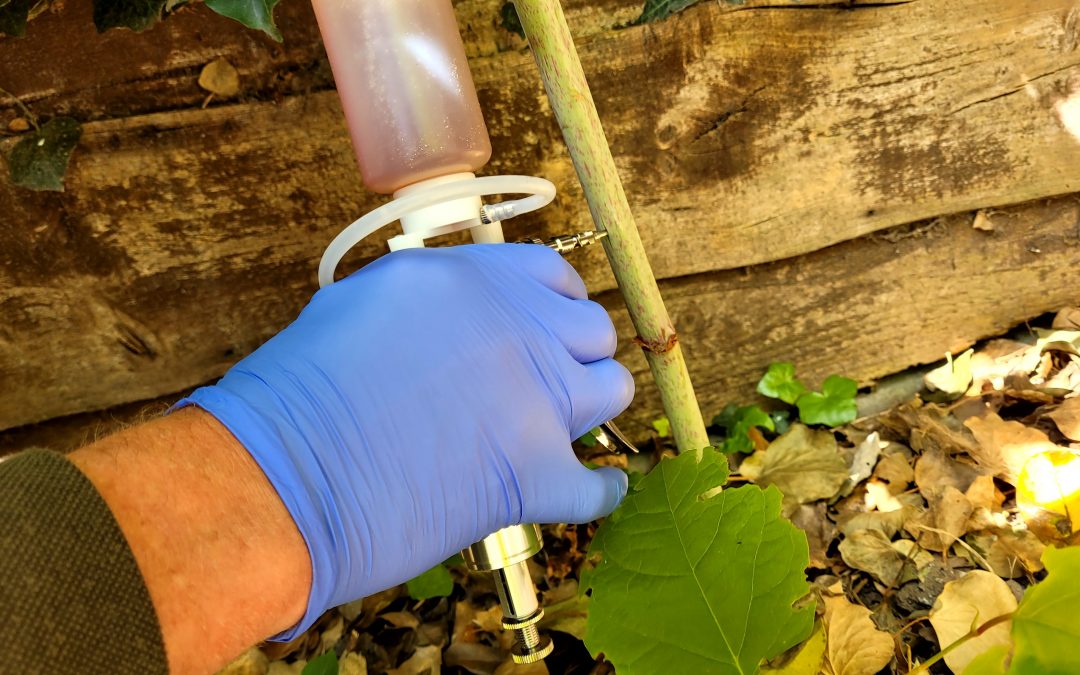I do get asked frequently if is it possible. Can you permanently get rid of knotweed?
Permanently eliminating Japanese knotweed is indeed feasible, albeit a challenging and time-consuming endeavour. Various treatment methods, such as excavation, herbicide treatment, and stem injection, exist, with the most suitable approach depending on the specific circumstances of the infestation.
Herbicide treatment
The predominant method employed is herbicide treatment, although it may require several years to completely eradicate the plant. This approach entails the utilization of specially formulated herbicides designed to exterminate the plant’s roots and shoots. Given its protracted nature, multiple treatments must be administered over an extended period.
Stem injection
A relatively recent treatment approach is stem injection, which entails directly injecting herbicides into the plant’s stem. This method proves effective for addressing small-scale infestations while minimizing disruption compared to other techniques.
Excavation
Excavation represents an alternative treatment option, but its feasibility is not always guaranteed due to the associated costs and practical limitations. This method involves the excavation and removal of the entire infestation, including the roots, followed by appropriate disposal at a licensed landfill site. However, if the excavation process is not meticulously supervised, it can inadvertently leave behind fragments of rhizome in the ground or unknowingly distribute them to other areas. Factors such as human error and negligence can significantly contribute to this outcome.
It is crucial to note that merely removing the visible signs of Japanese knotweed does not signify the resolution of the problem. The rhizome, or underground stem, can remain active for numerous years, potentially leading to regrowth if not appropriately treated. To ensure a comprehensive resolution, it is essential to establish a professional treatment plan and secure guarantees from the treatment company, covering any potential damage caused by the knotweed in the future.
State of Dormancy
Should the Japanese knotweed persist beyond the designated 5-year treatment period, it can be assumed that the plant has entered a dormant state and may have previously undergone some form of poisoning.
Dormancy periods for Japanese knotweed can vary, and there is no definitive timeframe for how long it can last. Dormancy refers to a state of temporary inactivity or reduced growth. In the case of Japanese knotweed, dormancy can occur when the plant is subjected to certain conditions or environmental factors that limit its growth and development.
The duration of dormancy can be influenced by a range of factors, including the specific location, climate, and overall health of the plant. In general, dormancy for Japanese knotweed can last anywhere from a few months to several years. During this period, the plant may exhibit minimal growth or show no visible signs of activity.
It’s important to note that even during dormancy, the rhizome (underground stem) of Japanese knotweed can remain viable and capable of regrowth if the conditions become favourable again. Therefore, it is crucial to implement appropriate treatment measures to address the plant effectively and prevent its re-emergence.
To gain a better understanding of the potential dormancy period and devise suitable strategies for managing Japanese knotweed, it is advisable to consult with a professional surveyor or expert specializing in Japanese knotweed treatment. They can provide accurate insights and guidance based on the specific circumstances and conditions of your situation.
To determine the optimal course of action for your specific circumstances, consulting with a specialized professional surveyor well-versed in Japanese knotweed treatment is of utmost importance.
